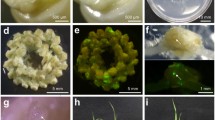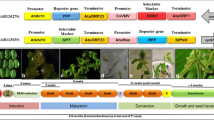Abstract
Direct gene transfer to floral meristems could contribute to cell-fate mapping, to the study of flower-specific genes and promoters, and to the production of transgenic gametes via the transformation of sporogenic tissues. Despite the wide potential of its applications, direct gene transfer to floral meristems has not been achieved so far because of the lack of suitable technology. We show in this paper that ballistic micro-targeting is the technique of choice for this purpose, and in this way, we were able to transfer genes efficiently into excised wheat immature spikes. Particle size was adjusted for optimal penetration into the L1 and L2 cell layers of the spikes with limited cell damage. Spikes at different developmental stages were shot either with a plasmid containing two genes involved in anthocyanin biosynthesis or with a plasmid bearing the uidA (β-glucuronidase) gene. The transient expression of these marker genes was observed in the different developmental stages tested and in cells of both the L1 and the L2 layers. The transient expression of the uidA gene was significantly increased when the sucrose concentration in the culture medium was increased from 0.06 to 0.52 M. At the highest concentration, 100% of the targeted spikes expressed the uidA gene, with an average of 69 blue cells per spike. Twelve days after microtargeting, multicellular sectors showing transgene expression and containing up to 17 cells were found in 85% of the shot immature inflorescences. This indicated that targeted cells survived particle bombardment. Sectors were found in primordia of both vegetative and reproductive organs.
Similar content being viewed by others
References
Barnabas B, Kovacs G (1992) In vitro pollen maturation and successful seed production in detached spikelet cultures in wheat (Triticum aestivum L.). Sex Plant Reprod 5:286–291
Bernier G (1988) The control of floral evocation and morphogenesis. Annu Rev Plant Physiol Plant Mol Biol 39:175–219
Bonnet OT (1966) Inflorescence of maize, wheat, rye, barley and oats: their initiation and development. University of Illinois College of Agriculture, Bull 721
Cone KC, Burr FA, Burr B (1986) Molecular analysis of the maize anthocyanin regulatory locus C1. Proc Natl Acad Sci USA 83:9631–9635
De Wet JR, Wood KV, DeLuca M, Helsinki DR, Subramani S (1987) Firefly luciferase gene: structure and expression in mammalian cells. Mol Cell Biol 7:725–737
Drews GN, Goldberg RB (1989) Genetic control of flower development. Trends Genet 5:256–261
Edwards JW, Coruzzi GM (1990) Cell specific gene expression in plants. Annu Rev Genet 24:275–303
Jefferson RA, Kavanagh TA, Bevan MW (1987) GUS-fusions: β-glucuronidase as a sensitive and versatile gene fusion marker in higher plants. EMBO J 6:3901–3907
Mandel MA, Gustafson-Brown C, Savidge B, Yanofsky MF (1992a) Molecular characterization of the Arabidopsis floral homeotic gene APETALA1. Nature 360:273–277
Mandel MA, Bowman JL, Kempin SA, Ma H, Meyerowitz EM, Yanofsky MF (1992b) Manipulation of flower structure in transgenic tobacco. Cell 71:133–143
Maniatis T, Fritsch EF, Sambrook J (1982) Molecular cloning (a laboratory manual). Cold Spring Harbor Laboratory, New York
McElroy D, Zhang W, Cao J, Wu R (1990) Isolation of an efficient actin promoter for use in rice transformation. Plant Cell 2:163–171
Mendel RR, Muller B, Schulze J, Kolesnikov V, Zelenin A (1989) Delivery of foreign genes to intact barley cells by high-velocity microprojectiles. Theor Appl Genet 78:31–34
Murashige T, Skoog F (1962) A revised medium for rapid growth and bio-assay with tobacco tissue culture. Physiol Plant 15:473–479
Nerson H, Sibony M, Pinthus MJ (1980) A scale for the assessment of the developmental stages of the wheat (Triticum aestivum L.) spike. Ann Bot 45:203–204
Ow DW, Wood KV, DeLuca M, De Wet JR, Helinski DR, Howell SH (1986) Transient and stable expression of the firefly luciferase gene in plant cells and transgenic plants. Science 234:856–859
Perl A, Kless H, Blumenthal A, Galili G, Galun E (1992) Improvement of plant regeneration and GUS expression in scutellar wheat calli by optimization of culture conditions and DNA-microprojectile delivery procedures. Mol Gen Genet 235:279–284
Potrykus I (1992) Micro-targeting of microprojectiles to target areas in the micrometer range. Nature 355:568–569
Radicella JP, Turks D, Chandler VL (1991) Cloning and nucleotide sequence of a cDNA encoding BPeru, a regulatory protein of the anthocyanin pathway in maize. Plant Mol Biol 17:127–130
Sanford JC (1988) The biolistic process. TIBTECH 6:299–302
Satina S, Blakeslee AF, Avery AG (1940) Demonstration of the three germ layers in the shoot apex of Datura by means of induced polyploidy in periclinal chimeras. Am J Bot 22:895–905
Sautter C (1993) Development of a microtargeting device for particle bombardment of plant meristems. Plant Cell Tissue Organ Culture 33:251–257
Sautter C, Waldner H, Neuhaus-Url G, Galli A, Neuhaus G, Potrykus I (1991) Micro-targeting: high efficiency gene transfer using a novel approach for the acceleration of micro-projectiles. Biotechnol 9:1080–1084
Sharman BC (1983) Developmental anatomy of the inflorescence of bread wheat (Triticum aestivum) during normal initiation and when affected by 2,4-D. Ann Bot 52:621–639
Sussex I (1989) Developmental programming of the shoot meristem. Cell 56:225–229
Vain P, McMullen MD, Finer JJ (1993) Osmotic treatment enhances particle bombardment-mediated transient and stable transformation of maize. Plant Cell Rep 12:84–88
Vasil V, Brown SM, Re D, Fromm ME, Vasil IK (1991) Stably transformed callus lines from microprojectile bombardment of cell suspension cultures of wheat. Biotechnol 9:743–747
Vasil V, Castillo AM, Fromm ME, Vasil IK (1992) Herbicide resistant fertile transgenic wheat plants obtained by microprojectile bombardment of regenerable embryogenic callus. Biotechnol 10:631–667
Wong JR, Walker LS, Krikeilis H, Klein TM (1991) Anthocyanin regulatory genes from maize (B-peru and C1) activate the anthocyanin pathway in wheat, barley, and oat cells. J Cell Biochem 15A:159
Ye GN, Daniell H, Sanford JC (1990) Optimization of delivery of foreign DNA into higher-plants chloroplasts. Plant Mol Biol 15:809–819
Author information
Authors and Affiliations
Rights and permissions
About this article
Cite this article
Leduc, N., Iglesias, V.A., Bilang, R. et al. Gene transfer to inflorescence and flower meristems using ballistic micro-targeting. Sexual Plant Reprod 7, 135–143 (1994). https://doi.org/10.1007/BF00230582
Received:
Accepted:
Issue Date:
DOI: https://doi.org/10.1007/BF00230582




